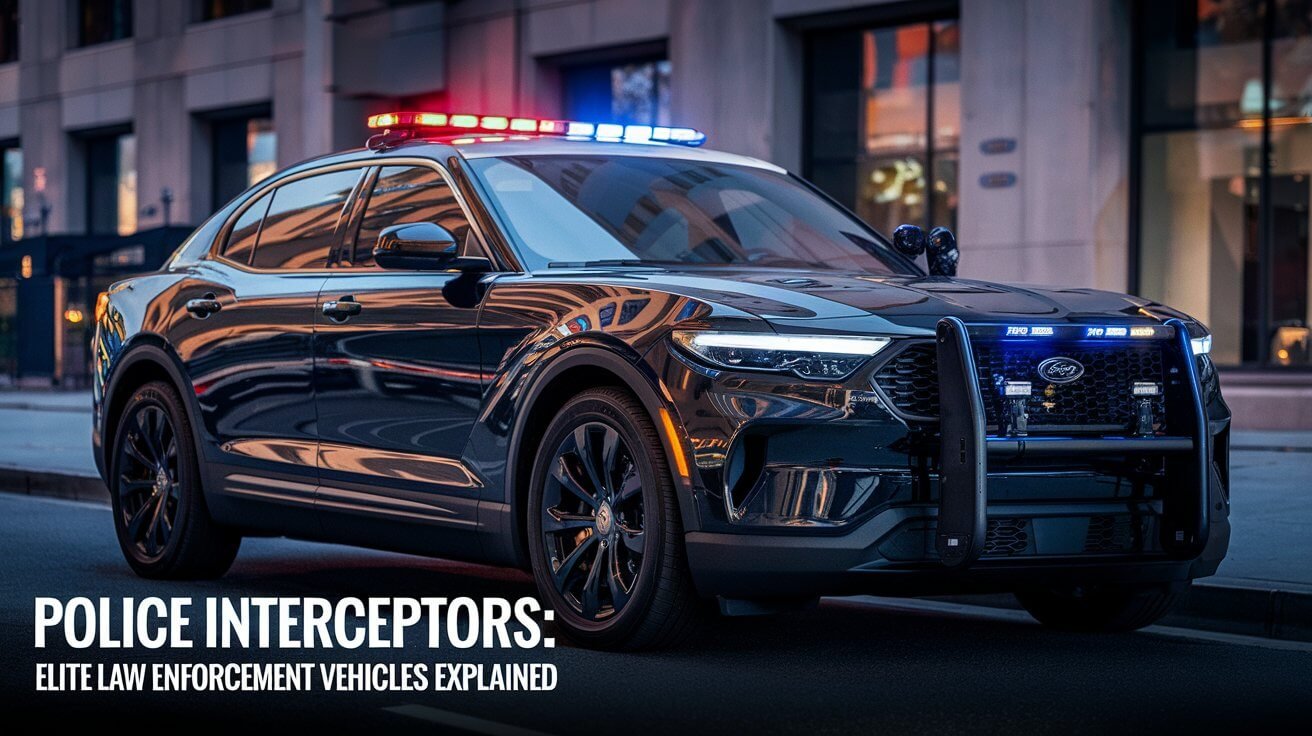Police Interceptors: Elite Law Enforcement Vehicles Explained

Police interceptors are specialized high-performance vehicles designed for law enforcement agencies to handle intense pursuits and emergency situations. These vehicles are built with enhanced engines, reinforced bodies, and advanced technology to meet the demanding needs of police work. Let’s check out what makes these special cars tick and why they matter for police work today.
The Evolution of Police Interceptors
Early Days of Police Vehicles
The story of police vehicles dates back to the early 20th century. In those days, officers used regular cars with minimal modifications. These early police cars were often indistinguishable from civilian vehicles, save for a siren or a police radio.
Birth of the Police Interceptor Concept
The term “Police Interceptor” emerged in the 1950s when Ford introduced its first purpose-built police package. This marked a significant shift in how law enforcement agencies approached their vehicle fleets. The idea was to create cars that could handle the rigors of police work better than standard consumer models.
Modern Police Interceptor Models
Today’s police interceptors are light years ahead of their predecessors. They’re engineered from the ground up to meet the unique demands of law enforcement. Modern interceptors blend high-speed capability with advanced safety features and cutting-edge technology.
Key Features of Police Interceptors
High-Performance Engines
Police interceptors pack a punch under the hood. Many models feature powerful V6 or V8 engines that deliver quick acceleration and high top speeds. For example, the Ford Police Interceptor Utility boasts a 3.0L EcoBoost engine capable of producing 400 horsepower.
Enhanced Suspension and Braking Systems
Chases and rapid response calls put enormous stress on a vehicle. That’s why police interceptors come equipped with heavy-duty suspensions and high-performance brake systems. These upgrades allow for better handling and shorter stopping distances, crucial for officer and public safety.
Reinforced Body and Safety Features
Police work can be dangerous. Interceptors often include reinforced body panels and frames to protect officers in case of collisions. Many models also feature ballistic door panels to guard against gunfire. The Ford Police Interceptor Utility, for instance, is designed to withstand a 75 mph rear impact crash.
Specialized Interior and Equipment
Inside, police interceptors look quite different from their civilian counterparts. They’re outfitted with rugged, easy-to-clean materials and custom-designed seats to accommodate officers wearing duty belts. Many also feature built-in equipment mounts for computers, radios, and other essential gear.
Popular Police Interceptor Models
Ford Police Interceptor Utility
Based on the Ford Explorer, this SUV has become a favorite among police departments. It offers a blend of performance, space, and versatility that suits a wide range of law enforcement needs.
Dodge Charger Pursuit
For agencies preferring a sedan, the Dodge Charger Pursuit is a popular choice. It combines muscle car performance with police-specific features, making it a formidable pursuit vehicle.
Chevrolet Tahoe PPV
The Chevrolet Tahoe Police Pursuit Vehicle (PPV) offers a full-size SUV option for agencies needing extra space and towing capacity without sacrificing performance.
Technology in Police Interceptors
Advanced Communication Systems
Modern police interceptors are rolling command centers. They’re equipped with sophisticated radio systems, allowing officers to communicate seamlessly with dispatch and other units. Many also feature built-in Wi-Fi hotspots for mobile data access.
On-Board Computers and Data Management
Laptops or tablet computers are standard in most interceptors. These devices give officers instant access to databases, report writing software, and other crucial information systems while on patrol.
Pursuit Management Technology
Some interceptors now include technology to help manage high-speed pursuits. Features like GPS tracking and remote vehicle disabling systems can help end dangerous chases more safely.
Police Interceptors vs. Regular Police Cars
Performance Differences
Police interceptors significantly outperform standard police cars in acceleration, top speed, and handling. This superior performance is crucial for catching up to fleeing suspects and responding quickly to emergencies.
Durability and Longevity
Built to withstand the demands of 24/7 use, police interceptors often last longer than regular police cars. Their heavy-duty components can handle frequent high-speed driving, sudden stops, and rough road conditions.
Cost Considerations
While police interceptors cost more upfront than regular police cars, many agencies find them more cost-effective in the long run. Their durability and specialized features can reduce maintenance costs and improve officer efficiency.
Training for Police Interceptor Drivers
Specialized Driving Techniques
Driving a police interceptor isn’t like driving a regular car. Officers undergo specialized training to handle these high-performance vehicles safely. This training often includes high-speed driving courses and simulated pursuit scenarios.
Maintenance and Care
Proper maintenance is crucial for keeping police interceptors in top condition. Officers learn basic maintenance checks and how to spot potential issues early, helping to extend the life of these valuable assets.
The Future of Police Interceptors
Electric and Hybrid Models
As automotive technology evolves, so do police interceptors. Many agencies are now exploring electric and hybrid options. Ford’s Police Interceptor Utility Hybrid, introduced in 2020, offers improved fuel efficiency without sacrificing performance.
Autonomous Features
While fully autonomous police cars are still in the realm of science fiction, some autonomous features are making their way into interceptors. These might include advanced driver assistance systems or semi-autonomous modes for certain situations.
Advanced Materials and Design
Future police interceptors may incorporate lightweight, high-strength materials to improve performance and fuel efficiency. Aerodynamic designs could also play a larger role in next-generation models.
Impact of Police Interceptors on Law Enforcement
Improved Response Times
The superior performance of police interceptors allows officers to respond to calls faster. This can be crucial in emergency situations where every second counts.
Enhanced Officer Safety
With their reinforced structures and advanced safety features, police interceptors provide better protection for officers. This can give officers more confidence in high-risk situations.
Public Perception and Community Relations
The visible presence of police interceptors can have mixed effects on community relations. While some see them as a symbol of safety and protection, others may view them as intimidating. Agencies must balance the need for high-performance vehicles with community engagement efforts.
Purchasing and Maintaining Police Interceptors
Procurement Process for Law Enforcement Agencies
Buying police interceptors involves a complex process for most agencies. It often includes competitive bidding, budget approvals, and careful consideration of long-term costs and benefits.
Customization Options
Many manufacturers offer a range of customization options for police interceptors. This allows agencies to tailor their vehicles to specific needs, whether that’s additional lighting, specialized storage, or unique paint schemes.
Long-Term Maintenance Strategies
Given the high cost and critical nature of police interceptors, many agencies develop comprehensive maintenance strategies. These often include regular servicing schedules, detailed record-keeping, and partnerships with specialized service centers.
Police Interceptors Around the World
Variations in Different Countries
While American-style police interceptors are common in many countries, others have their own unique approaches. In Germany, for example, high-performance BMWs and Mercedes are often used for autobahn patrols.
International Collaborations and Standards
There’s growing collaboration between countries on police vehicle standards. This includes sharing best practices for vehicle design, safety features, and pursuit policies.
Conclusion
Police interceptors have come a long way since the early days of law enforcement vehicles. Today, they represent the cutting edge of automotive technology, specially designed to meet the unique challenges of police work. As we look to the future, it’s clear that police interceptors will continue to evolve, incorporating new technologies and adapting to changing law enforcement needs.
From high-speed pursuits to community patrols, these specialized vehicles play a crucial role in modern policing. They’re not just cars – they’re mobile offices, safety devices, and powerful tools that help officers serve and protect their communities effectively.
As automotive technology advances, we can expect to see even more impressive police interceptors hit the streets. Whether it’s through improved fuel efficiency, enhanced safety features, or cutting-edge communications technology, these vehicles will continue to be at the forefront of law enforcement innovation.






